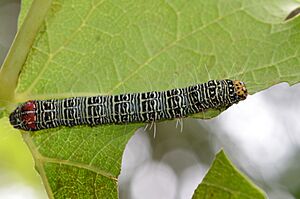Australian grapevine moth facts for kids
Quick facts for kids Australian grapevine moth |
|
|---|---|
 |
|
| Scientific classification | |
| Synonyms | |
|
The Phalaenoides glycinae, also known as the Australian grapevine moth, is a type of moth. It belongs to the Noctuidae family. This moth is originally from southeastern Australia. The first description of this species was made by John Lewin in 1805.
Contents
What Does the Australian Grapevine Moth Look Like?
The Caterpillar
When it is a young caterpillar, this moth is black. It has pale yellow lines that go across its body. This makes it look a bit like a checkerboard pattern. It has soft skin with long, thin white hairs. Its head is light brown, and it has red spots near its head. There is also a clear red bump at the back of its body. The caterpillar usually rests on the underside of the leaves it eats.
The Adult Moth
The adult moth flies during the day. It has black wings that can spread up to 5 cm wide. Its front wings have white bands, and its back wings have a white edge. The top part of its body (the abdomen) is black, but it has orange bands underneath.
The moth also has bright red hairs. These hairs are found at the end of its body and near its legs. You can see these red hairs sticking out from the top. Male moths have special organs at the front of their bodies. These organs release pheromones, which are chemical signals. Adult moths are social and feed on nectar. They usually live for about 2 to 3 weeks. These moths can fly very high, sometimes over 25 meters!
Where Do Australian Grapevine Moths Live?
This moth is naturally found in the southeastern part of Australia. However, it has also spread to many other parts of the world. It is now considered an invasive species in places like New Zealand, Canada, and South Africa. This means it has moved to new areas and can sometimes cause problems there.
What Do Australian Grapevine Moths Eat?
The young moths, or larvae, eat several types of plants. They feed on plants like Parthenocissus quinquefolia, Hibbertia obtusifolia, Amyema gaudichaudii, Epilobium ciliatum, Fuchsia, and Oenothera species. However, they mostly eat Vitis vinifera, which is the common grapevine. Because they eat grapevines, they are sometimes seen as an agricultural pest. This means they can cause damage to crops, especially grapes.
How Are They Controlled?
In 1862, a bird called the Indian myna (Acridotheres tristis) was brought to Australia. The idea was for these birds to help control insect pests, including the grapevine moth. However, this plan did not work well. The Indian myna birds were not successful in controlling the moths. In fact, the Indian myna bird itself is now considered a pest in many parts of Australia.
Gallery
See also
 In Spanish: Phalaenoides glycinae para niños
In Spanish: Phalaenoides glycinae para niños










